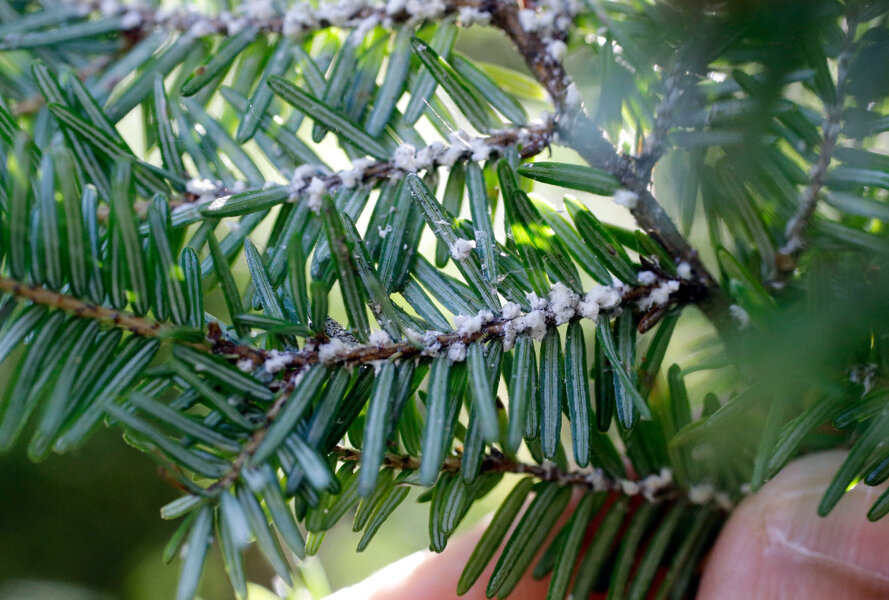Climate change strengthens an army of forest-eating insects
Loading...
A tiny bug, no bigger than a grain of pepper, is wreaking big-time havoc in US forests, and forest managers are scrambling to keep up.
Hemlock woolly adelgids aren't native to North America, but droves of them have taken up residence in hemlock forests, from New England to the West Coast, thanks to increased trade and travel. Nestled under the needles of hemlock trees, the invasive insects cut off nutrients to the tree and can eventually take down trees that have stood for 300 years.
If left unchecked, the hemlock woolly adelgid and other pests are projected to put 63 percent of the nation's forests at risk by 2027, according to a study published this year in the journal Ecological Applications. The tiny invaders could put several species of hemlock at risk for extinction, threatening the biodiversity and stability of ecosystems across the country and cutting a carbon sink for mitigating greenhouse gas emissions. [Editor's note: This paragraph has been corrected to reflect that this statistic includes multiple invasive pests.]
Globalization has opened the door for hundreds of invasive pests, from the Asian longhorned beetle to the emerald ash borer. And climate change, it seems, will make it even more difficult to evict them.
“The primary driver of the invasive pest problem is globalization, which includes increased trade and travel,” Andrew Liebhold, a US Forest Service research entomologist in West Virginia, told the Associated Press. “But there are cases where climate change can play an important role. As climates warm, species are able to survive and thrive in more northerly areas.”
The hemlock woolly adelgid was transported from Japan to Richmond, Va., on an Asian hemlock tree that was brought in for landscaping in the 1920s, but the species did not become such an explosive pest problem until the 1980s.
The pest concentrates on the Eastern hemlock and “ultimately disrupts the flow of nutrients to the needle and it has this cascading effect where once the nutrients stop flowing to the needle, then the needles start to die, the twigs start to die and then the limbs and then you see mortality anywhere between four and ten years,” Casey Reese, regional integrated pest coordinator for the Northeast region National Park Service, tells The Christian Science Monitor in a phone interview.
Since the hemlock woolly adelgids are not native to this continent, they have no natural predators and thus remain unchecked.
While, cold nights that reach 10 to 20 degrees F. below zero will kill the insect, “those cold winter nights are becoming less frequent because of climate change,” study author Gary Lovett tells the Monitor adding that “The insect itself seems to be evolving to become more cold tolerant as it goes along.”
Even after the tree dies, the hemlock woolly adelgid indirectly impacts the functioning of the ecosystem – particularly for the more than 90 bird species, 45 mammals species, and countless aquatic macro-invertebrates for whom the trees provide a habitat, James Howard of the National Parks Service, says in an email to the Monitor.
“In those very specific areas, once the tree dies, the limbs fall the ground and light hits forest floor and creates very different conditions such that the soil, macrofauna, and microfauna are not used to those conditions and it can effectively change the entire ecosystem in a manner that is sometimes unpredictable and can change the composition of the forest," Mr. Reese says.
This can affect adjacent ecosystems, such as streams running through a forest, as well.
“Hemlock often grow along streams,” Dr. Lovett says, “So when that tree dies it often opens up the stream to more light and higher temperatures and that can affect the fish populations of the stream, especially those fish that require cooler waters because the stream is no longer shaded.”
Hemlock trees also serve as nesting sites for birds, and while the birds have not been shown to die off as a result, their nesting patterns change, which may in turn affect other species.
“It’s a great example of how one species can make a difference in the forest,” Harvard University ecologist David Orwig told the Associated Press.
Pests across the United States, including the hemlock woolly adelgid end up costing nearly $4 billion annually, the majority of which ends up on homeowners forced to removed dead trees and potentially diminished property value, and on city governments, which also absorb the costs of removing and replacing trees in parks and along streets, according to Lovett.
Scientists have tried a variety of methods in order to mitigate the affect these bugs have on the trees, their ecosystem, and the economy, including introducing biological controls, such as the natural predators and parasites of the hemlock woolly adelgid imported from Asia, with limited success.
Individual trees can be treated biennially in order to keep the pests away, but that is not a practical solution when applied to an entire forest. In that regard, scientists are still searching for answers.
Lovett and his team at the Cary Institute are looking at the problem with a broader perspective.
“We are providing policies that we think will reduce the importation of new pests through global trade,” Lovett says. “The types of policies we are encouraging are phasing out the use of wood packing material like wood crates and pallets in favor of other materials like manufactured wood like plywood and composite wood ... restricting the importation of live woody plants that are brought in for horticulture, and increasing our surveillance systems so we can catch these outbreaks before they get to be large.”








